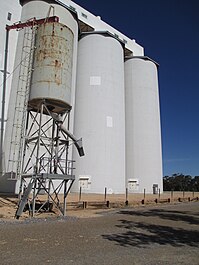Yinkanie railway line
| Yinkanie railway line | ||||||||||||||||||||||||||||||||||||||||||||||||||||||||||||||||||||||||||||||||||||
|---|---|---|---|---|---|---|---|---|---|---|---|---|---|---|---|---|---|---|---|---|---|---|---|---|---|---|---|---|---|---|---|---|---|---|---|---|---|---|---|---|---|---|---|---|---|---|---|---|---|---|---|---|---|---|---|---|---|---|---|---|---|---|---|---|---|---|---|---|---|---|---|---|---|---|---|---|---|---|---|---|---|---|---|---|
 Chute for loading bulk grain into trains at Wunkar (the only station on the line to have bulk storage and loading facilities) in 2015 | ||||||||||||||||||||||||||||||||||||||||||||||||||||||||||||||||||||||||||||||||||||
| Overview | ||||||||||||||||||||||||||||||||||||||||||||||||||||||||||||||||||||||||||||||||||||
| Status | Closed and removed | |||||||||||||||||||||||||||||||||||||||||||||||||||||||||||||||||||||||||||||||||||
| Termini | ||||||||||||||||||||||||||||||||||||||||||||||||||||||||||||||||||||||||||||||||||||
| Continues from | Barmera line | |||||||||||||||||||||||||||||||||||||||||||||||||||||||||||||||||||||||||||||||||||
| Service | ||||||||||||||||||||||||||||||||||||||||||||||||||||||||||||||||||||||||||||||||||||
| System | South Australian Railways | |||||||||||||||||||||||||||||||||||||||||||||||||||||||||||||||||||||||||||||||||||
| History | ||||||||||||||||||||||||||||||||||||||||||||||||||||||||||||||||||||||||||||||||||||
| Opened | 4 September 1925 | |||||||||||||||||||||||||||||||||||||||||||||||||||||||||||||||||||||||||||||||||||
| Closed | 1 May 1971 | |||||||||||||||||||||||||||||||||||||||||||||||||||||||||||||||||||||||||||||||||||
| Technical | ||||||||||||||||||||||||||||||||||||||||||||||||||||||||||||||||||||||||||||||||||||
| Line length | 49.6 km (30.8 mi) | |||||||||||||||||||||||||||||||||||||||||||||||||||||||||||||||||||||||||||||||||||
| Track gauge | 1600 mm (5 ft 3 in) | |||||||||||||||||||||||||||||||||||||||||||||||||||||||||||||||||||||||||||||||||||
| ||||||||||||||||||||||||||||||||||||||||||||||||||||||||||||||||||||||||||||||||||||
The Yinkanie railway line was a 50.6 kilometres (31.4 mi) railway line on the South Australian Railways network. Named the Wanbi to Moorook Railway in its enabling Act, it never reached its intended destination on the River Murray.[1] The railway ran from a junction with the Barmera line at Wanbi northwards to Yinkanie, opening on 7 September 1925 and closing on 1 May 1971.[2]
| The six railway lines of the Murraylands[3][4] | |||||
| Order built |
Line | Year opened |
Year closed |
Length (mi) |
Length (km) |
|---|---|---|---|---|---|
| 1 | Tailem Bend–Pinnaroo | 1906 | 2015[note a] | 86.6 | 139.4 |
| 2 | Tailem Bend–Barmera | 1913 / 1928[note b] |
1996[note c] | 159.5 | 256.6 |
| 3 | Karoonda–Peebinga | 1914 | 1990 | 66.0 | 106.2 |
| 4 | Karoonda–Waikerie | 1914 | 1994[note d] | 73.8 | 118.7 |
| 5 | Alawoona–Loxton | 1914 | 2015[note e] | 22.0 | 35.5 |
| 6 | Wanbi–Yinkanie | 1925 | 1971 | 31.5 | 50.6 |
| Total | 439.4 | 707.0 | |||
Notes
 | |||||
Route
The route of the line was designed to cover the gap between the Waikerie and Loxton lines at the lowest cost.[1] The names of the new stations were Gluyas, Caliph, Bayah, Tuscan, Koowa, Wunkar, Myrla, Wappilka and Yinkanie.
References
- ^ a b "The Moorook Railway". The Chronicle. Adelaide: National Library of Australia. 12 September 1925. p. 52. Retrieved 27 June 2014.
- ^ Quinlan, Howard; Newland, John (2000). Australian Railway Routes 1854 - 2000. Redfern: Australian Railway Historical Society. p. 54. ISBN 0 909650 49 7.
- ^ Quinlan, Howard; Newland, John R. (2000). Australian railway routes 1854–2000. Redfern, New South Wales: Australian Railway Historical Society, New South Wales Division. pp. 53–54. ISBN 0909650497.
- ^ Map showing lines of railways in South Australia and through mileages (Map). Adelaide: South Australian Railways. 1958 – via National Railway Museum, Port Adelaide.
External links
![]() Media related to Moorook railway line at Wikimedia Commons
Media related to Moorook railway line at Wikimedia Commons
